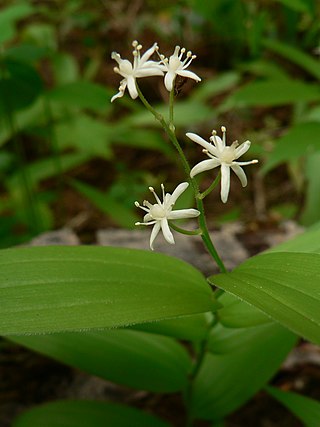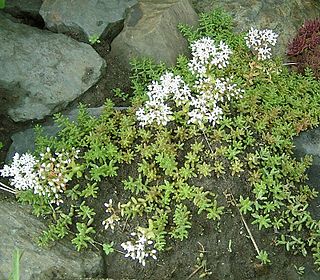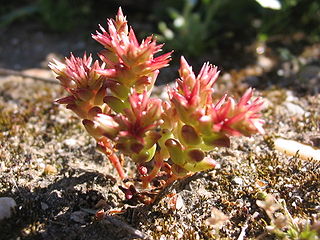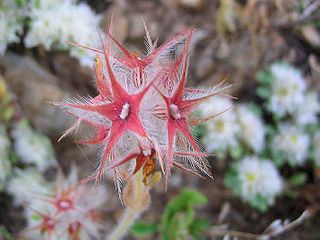
The Crassulaceae, also known as the stonecrop family or the orpine family, are a diverse family of dicotyledon flowering plants characterized by succulent leaves and a form of photosynthesis, known as Crassulacean acid metabolism (CAM). Flowers generally have five floral parts. Crassulaceae are usually herbaceous but there are some subshrubs, and relatively few treelike or aquatic plants. Crassulaceae are a medium-sized monophyletic family in the core eudicots, among the order Saxifragales, whose diversity has made infrafamilial classification very difficult. The family includes approximately 1,400 species and 34–35 genera, depending on the circumscription of the genus Sedum, and distributed over three subfamilies. Members of the Crassulaceae are found worldwide, but mostly in the Northern Hemisphere and southern Africa, typically in dry and/or cold areas where water may be scarce, although a few are aquatic.

Sedum is a large genus of flowering plants in the family Crassulaceae, members of which are commonly known as stonecrops. The genus has been described as containing up to 600 species, subsequently reduced to 400–500. They are leaf succulents found primarily in the Northern Hemisphere, but extending into the southern hemisphere in Africa and South America. The plants vary from annual and creeping herbs to shrubs. The plants have water-storing leaves. The flowers usually have five petals, seldom four or six. There are typically twice as many stamens as petals. Various species formerly classified as Sedum are now in the segregate genera Hylotelephium and Rhodiola.

Sedum acre, commonly known as the goldmoss stonecrop, mossy stonecrop, goldmoss sedum, biting stonecrop, and wallpepper, is a perennial flowering plant in the family Crassulaceae. It is native to Europe, northern and western Asia and North Africa, but is also naturalised in North America, Japan, and New Zealand.

Petrosedum rupestre, also known as reflexed stonecrop, Jenny's stonecrop, blue stonecrop, stone orpine, prick-madam and trip-madam, is a species of perennial succulent flowering plant in the family Crassulaceae, native to northern, central, and southern Europe.
Typical flora of Malta consist of the following plants. While small compared to other countries, the Maltese Islands contain flowers that grow on Malta, Gozo, Comino, Filfla, St Paul's Islands and Fungus Rock. Many of the species are endemic to Malta.

Hylotelephium telephium, known as orpine, livelong, frog's-stomach, harping Johnny, life-everlasting, live-forever, midsummer-men, Orphan John, witch's moneybags, and garden stonecrop is a succulent perennial plant of the family Crassulaceae native to Eurasia. The flowers are held in dense heads and can be reddish or yellowish-white. A number of cultivars, often with purplish leaves, are grown in gardens as well as hybrids between this species and the related Hylotelephium spectabile (iceplant), especially the popular 'Herbstfreude'. Occasionally garden plants may escape and naturalise as has happened in parts of North America.

Hylotelephium is a genus of flowering plants in the stonecrop family Crassulaceae. It includes about 33 species distributed in Asia, Europe, and North America.

Maianthemum stellatum is a species of flowering plant, native across North America. It has been found in northern Mexico, every Canadian province and territory except Nunavut, and every US state except Hawaii and the states of the Southeast. It has little white buds in the spring, followed by delicate starry flowers, then green-and-black striped berries, and finally deep red berries in the fall.

Sedum album, the white stonecrop, is a flowering plant of the genus Sedum in the family Crassulaceae. It is found in the northern temperate regions of the world, often growing in crevices or free-draining rocky soil. As a long-day plant it grows vegetatively for most of the year and flowers in summer.

Sedum rubrotinctum or Sedum × rubrotinctum, commonly known as jelly-beans, jelly bean plant, or pork and beans, is a species of Sedum from the plant family Crassulaceae. It is a succulent plant originating in Mexico. The common English name refers to its short leaves that resemble jelly beans, especially when taking on a protective hue.

Allium stellatum, commonly known as the autumn onion, prairie onion, cliff onion, or glade onion, is a North American species of wild onion in the Amaryllidaceae family that is native to central Canada and the central United States.

Sedum lanceolatum is a species of flowering plant in the stonecrop family known by the common names lanceleaf stonecrop and spearleaf stonecrop.

Sedum spathulifolium is a species of flowering plant in the family Crassulaceae known by the common names broadleaf stonecrop, yellow stonecrop, and spoon-leaved stonecrop. An evergreen perennial, it is native to western North America from British Columbia to southern California, where it can be found often in shade in many types of rocky habitat in coastal and inland hills and mountains.

Sedum dasyphyllum, also named Sedum burnatii and commonly known as Corsican stonecrop or thick-leaved stonecrop, is a low-growing succulent flowering plant of the genus Sedum in the family Crassulaceae.

Sedum adolphi, the coppertone stonecrop or golden Sedum, is a species of succulent plant in the family Crassulaceae. It is native to Mexico, where it grows in rocky terrain and on cliff faces. It has also become naturalized in Sicily and the Canary Islands. It is known for its bright orange-copper leaves and white flowers that bloom in the spring.

Sedum cespitosa is a species of annual herb in the family Crassulaceae. It has a self-supporting growth form and simple, broad leaves. Individuals can grow to 3 cm.

Sedum litoreum is a species of succulent annual herb in the family Crassulaceae. Individuals can grow to 3.7 cm. It is native to the central and eastern Mediterranean, from Corsica and Sardinia to Italy, Sicily, former Yugoslavia, Albania, Greece and the Greek Islands, Turkey, Cyprus, and the Levant.

Sedum rubens is a species of annual herb in the family Crassulaceae. They are succulent plants. They have a self-supporting growth form and simple, broad leaves. Individuals can grow to 5.4 cm.

Trifolium stellatum, the star clover, is a species of annual herb in the family Fabaceae. They have a self-supporting growth form and compound, broad leaves. Flowers are visited by mason bees, Anthocopa, Osmia aurulenta, and Anthophora. Individuals can grow to 0.11 m.

Sedum album subsp. rupimelitense is a plant subspecies belonging to the Crassulaceae family. It is an endemic taxon in the Maltese Islands and is found growing on sea cliffs and rock faces. This taxon is often referred to as the Maltese stonecrop due to its growth on rocky outcrops.


















